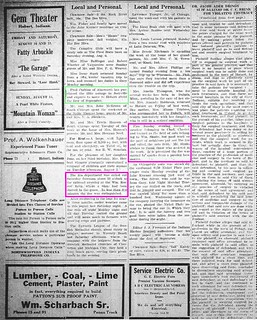
(Click on image to enlarge)
Hobart News 4 Aug. 1921.
William Rossow's farm, of course, lay on the west side of Wisconsin Street at the crossing of the (former) Pennsy Railroad. Charles Chester's land was divided by the Grand Trunk Railroad, and if the fire was threatening the Shults oats, it was probably on the Chester land on the south side of the tracks.
And we already knew where Fred Carbein was moving from; now we know where he was moving to — more or less, since I couldn't tell you exactly where in Joryville the "Hite cottage" was.

1 comment:
My maternal g'father Fred Carbine was the youngest of nine children born to Christian and Caroine Kegebein. He married Anna Buchfuehrer. My mom was their youngest child born in 1921. She said they lived in the house in Ainsworth which is now 7237 Hwy 51 at that time. They moved to 726 Lincon St. where they raised their family and lived until their deaths. My mom told me that the house originally did not have a basement, so it was raised up and a basement was dug out. I have many happy memories of that house and even got to see the inside with my mom years later when my neighbor's daughter bought the house. My grandfather as a young man worked for the Wood family in Deep River at their store, then delivered for Roper and Brown, so this was probably the grain dealer as per the blurb. Will find the pic I have of him and forward it to you.
Post a Comment